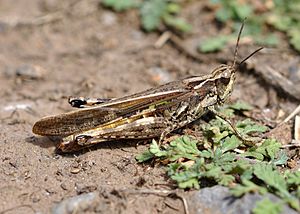Moroccan locust facts for kids
Quick facts for kids Moroccan locust |
|
|---|---|
 |
|
| Scientific classification | |
| Genus: |
Dociostaurus
|
| Species: |
maroccanus
|
| Synonyms | |
|
|
The Moroccan locust (scientific name: Dociostaurus maroccanus) is a type of grasshopper. It belongs to the insect family called Acrididae. You can find these locusts in parts of northern Africa, southern and eastern Europe, and western Asia.
Most of the time, they live alone. But in some years, their numbers grow very fast. When this happens, they gather in huge groups called swarms. These swarms can cause a lot of damage to farms and crops. The Moroccan locust was first described by Carl Peter Thunberg in 1815.
Contents
Where Do Moroccan Locusts Live?
The Moroccan locust lives in many places. Its home range stretches from the Canary Islands and Madeira in the west. It goes all the way to Kazakhstan and Afghanistan in the east.
In Africa, you can find them in Algeria, Egypt, Libya, Morocco, and Tunisia. In Europe, they live in France, Portugal, Spain, Italy, and the Balkan countries. They are also found across the Middle East and Central Asia.
What Does a Moroccan Locust Look Like?
Moroccan locusts lay their eggs in groups called pods. Each pod holds about thirty eggs. When the eggs hatch, tiny young locusts come out. These young ones are called "hoppers" or nymphs. They look like small adults but do not have wings.
Hoppers grow by shedding their skin five times. Each time they shed, they get bigger. Their wing pads also grow larger with each stage.
An adult female locust is usually 20 to 38 millimeters long. The male is a bit smaller, about 16 to 28 millimeters long. Their bodies are yellowish-gray with dark spots. They have a creamy cross-shape on their back, right behind the head.
Their main wings, called elytra, are big and clear. Sometimes, they have brown speckles. The underwings are clear and have strong veins. Their back legs are very strong. The upper part of the leg, called the femur, often has black bands. The lower part, the tibia, is usually red. It takes about 30 days for a locust to grow from a hatched egg to a full adult.
Moroccan Locust Life and Habits
The Moroccan locust likes to live in dry areas. These areas are usually between 500 and 1000 meters above sea level. They lay their eggs in soil that has not been disturbed, like open grasslands. They do not lay eggs in farm fields.
For the locusts to grow well, they need about 100 millimeters of rain from March to May. If the spring is very hot and dry, especially for two years in a row, many young locusts can hatch.
When many hoppers hatch, they can destroy all the plants where they were born. As they grow, hoppers start to gather in large groups. There can be thousands of hoppers in just one square meter! These groups of hoppers move downhill. They eat crops and plants as they go.
Sometimes, different generations of locusts are alive at the same time. The number of adult locusts can quickly reach 300 individuals per square meter. Adult locusts can fly together in huge swarms. They fly low to the ground, moving at about 8 to 10 meters per second. A swarm can travel up to 60 kilometers in one season. Their numbers start to go down in June as plants begin to dry out.
Why Moroccan Locusts Are a Problem
For a long time, the Moroccan locust has been a big threat to farming. They come in huge numbers and eat almost all kinds of plants. Their ability to fly in swarms makes them a feared pest.
However, in recent years, there have been fewer large swarms. In some areas, the Moroccan locust has become rare. This is especially true in European countries. Here, they no longer seem to be a big problem for the economy. But in North Africa and parts of Central Asia, they are still common.
Scientists think these changes might be due to climate change. There might be less spring rainfall. Another important reason could be that more land is being used for farming instead of grasslands. Female locusts need undisturbed soil to lay their eggs. On the other hand, too much grazing by animals or cutting down trees can help the locusts thrive. This can make them even more destructive.
A study in Iran in 1956 looked at where locust outbreaks started. They found that outbreaks came from only eight specific areas. These places were usually in mountain foothills that used to have forests. Or they were in other rolling hills. The plants there were mostly annual grasses or shrub steppe with small shrubs.
These areas had plenty of green food in winter. This helped the female locusts live longer and lay more eggs. Outside these special areas, Moroccan locusts lived alone. But inside these areas, in some years, they would gather in groups.
Locusts need firm, bare soil to lay eggs. When the eggs hatch, the young hoppers move to taller and thicker plants. These areas usually got rain in winter and early spring. The average temperature was about 17°C just before and after egg-laying. Sheep and goats often grazed heavily in these spots, especially in winter. The study showed that specific weather, plants, and land features are needed for these locusts to breed in large numbers.
Images for kids






